Cucurbitaceae
The cucurbitaceae (Cucurbitaceae) are a family of typically tendril-climbing plants, generally herbaceous and geophytic or annual, with an inferior ovary and immature fruit of a pepónide, which diversified when it matured, adapting to different dispersal syndromes. They produce cucurbitacins that make the vegetative parts and immature, and sometimes also ripe, fruits taste very bitter and toxic to most animals. The bitter parts of some cucurbits are among the most bitter tastes known to come from plants; Cucurbitacins are diversified but they all share a part of the biosynthetic pathway, a single gene is enough to explain their presence or absence in different parts of the plant; varieties grown for human consumption lost cucurbitacins in some organs.
Many cucurbits are of great horticultural importance and several genera of "gourds" and many varieties of immature "sweet" (not bitter) belong to this family. Some examples are squashes and zucchini (ayotes, pipianes, pumpkins and courgettes, Cucurbita pepo, C. maxima, C. moschata, C. argyrosperma), the chilacayote or alcayota (Cucurbita ficifolia), melon and cucumber (ripe Cucumis melo and immature Cucumis sativus respectively), watermelon (Citrullus lanatus), gourd or porongo or mate (Lagenaria siceraria), sicana or melon or curuguay gourd (Sicana odorifera), sponge or vegetable sponge (Luffa), the chayote or air potato and the Costa Rican tacaco (Sechium edule and Sechium tacaco), the caigua or achojcha (Cyclanthera pedata), among many other edibles in Africa and Asia ripe or immature (genera Benincasa, Momordica, Trichosanthes, Coccinia).
Description
Differential characters
They have a single leaf per node. APWeb: "Cucurbits are easy to recognize. They are herbaceous vines or lianas with leaves usually rather covered by coarse trichomes (hairs), without stipules, with palmate venation. In the leaf axil there is usually a vegetative bud, a flower, a laterally displaced branching tendril, or some more complex organization than that. The plants are dioecious or monoecious, and the flowers have a hypanthus, an often complex androecium formed by sigmoid-shaped monothecal anthers, and an inferior ovary with parietal placentation. The corolla is usually more or less yellow, sometimes red. The seeds are more or less flattened".
Cucurbits differ from the similar Vitaceae (the vines) and Passifloraceae (the passion of Christ or mbaracuyás) in the position of their tendrils, which is "lateral" to the petiole, or at least not opposite to the petiole as in Vitaceae, nor in the leaf axil as in Passifloraceae (Dieterle 1976 for Guatemala).
Wild varieties are also distinguishable by the taste of cucurbitacins.
Description
Schaefer and Renner in Kubitzki (2011): "".
Diversity
The Latin American floras dealing with regions of temperate to warm climates and the Spanish ones have a morphological description of the family and genera found in the region they describe, they can be accessed in the libraries of institutions dedicated to botany such as universities or botanical gardens. The floras may be old and the latest species described in the region may not be found in them, so a consultation of the latest primary taxonomic literature (the latest taxonomic monographs and occurrence catalogs (checklists) of the family and their genera in the region) or with a local specialist may be necessary. The global diversity of the family is found in a global flora up to genus, in English and that has become a reference, in Schaefer and Renner in Kubitzki (2011), other online are that of Watson and Dallwitz (1992 onwards) with its interactive identification key, and that of APWeb. The last 3 incorporate the APG (2009) classification -they may have some differences-, although the family is old and stable in the conceptualization that Today we know about her. A relatively recent book, in English, has been devoted to the description of the different aspects of the family, including cultivation, uses, etc. and it has become a must-read to start in the family, it is the Robinson and Decker-Walters (1997) Cucurbits.
The taxonomic diversity of Cucurbits is presented in detail by Schaefer and Renner in Kubitzki (ed., 2011).
The following is a small incomplete list of the diversity of cucurbits. The descriptions are deliberately incomplete. For more information follow the links.
Luffa
The fruit of Luffa when ripe is a pixidium with a fibrous mesocarp.
- Luffa
Citrullus
Fruit: watermelon. Inner mesocarp juicy, middle (white) mesocarp solid and forming part of the "armor".
Cucumis
Fruit: melon, cucumber.
Cucurbita
Fruit: pumpkins, alcayota. Woody exocarp, they are "pumpkins".
Lagenaria
Fruit: gourds with a very woody exocarp, durable for several years.
Sicana
Fruit: gourd with watery pulp, durability about 6 months, pulp somewhat similar to melon.
Benincasa
Fruit: gourd with watery pulp, durability for a little over a year due to the waxy layer that covers it.
Cyclanthera
Fruit: immature is the "stuffing cucumber".
Coccinia
Coccinia is restricted to the African continent, except for one edible species, Coccinia grandis. The fruit of Coccinia ripens into a red or orange berry from the distal to the proximal sector. The latest taxonomic monograph of the genus is that of Holstein (2015).
- Coccinia
Trichosanthes
The fruits of Trichosanthes are externally similar to Coccinia (the seeds may be dark), but they are distributed in tropical Asia and Australia except for Trichosanthes cucumerina var. anguina which is also cultivated in Africa. In addition to its fruit, it has typically white and fimbriated petals, with an elongated and fragrant floral tube, adapted to nocturnal pollination by lepidoptera.
- Trichosanthes
Dendrosicyos
The only tree in the family, Dendrosicyos with its only species, is a pachycaulus that gained its arborescent habit from its ancestral climbing habit. In English it is called cucumber tree, the "cucumber tree". Its herbaceous branches are pendulous. It survives as a relict on the island of Socotra (off the coast of the Horn of Africa) but is twice as old, so it is postulated that it was previously more widely distributed.
Phylogeny
The most modern phylogenetic hypothesis of the order and its classification into families and genera (with special detail in Cucurbitaceae) can be found in Schaefer and Renner (2011), published the same year as the article Cucurbitaceae on Kubitzki's flora (ed.). See also on APWeb (in English)
Taxonomy
Primary taxonomic literature:
In his Species Plantarum (1753) Linnaeus named the genus Cucurbita L. which at that time contained 5 species that today are 3 varieties of Cucurbita pepo and two species transferred to other genera: the wine gourd Lagenaria siceraria and the watermelon Citrullus lanatus. Antoine-Laurent de Jussieu later assigned the genera to families and used Cucurbita as the type genus of the family Cucurbitaceae, published in Genera Plantarum 393–394. 1789.
Current classification is usually based on the APG, see especially the description of the family and its genera in Schaeffer and Renner in Kubitzki (2011).
A checklist of the cucurbits of India was published by Renner and Pandey (2012).
Economic importance
Its edible species have more economic importance than is normally recognized, since they are typically used for food and local marketing in the same place where they are grown, in small and sustainable agricultural systems, whose data are not tabulated. Virtually all home gardens in temperate to warm climates grow at least one of them.
Quotes
- ↑ Dieterle (1976): "... lateral tendrils with the petioles (not opposite as in Vitaceae, not in the axils as in Passifloraceae)..."
Contenido relacionado
Beekeeping
Hominoid
Mushroom


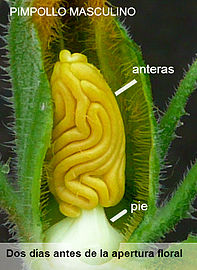
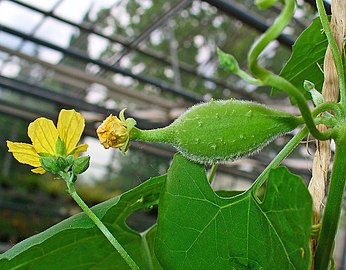

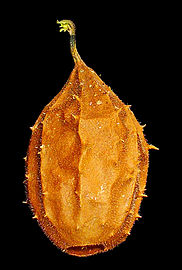
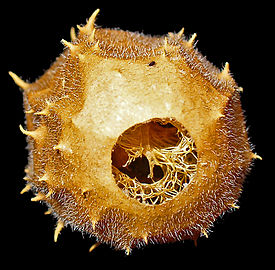

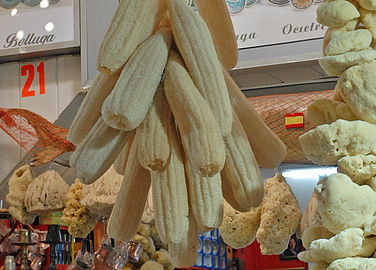





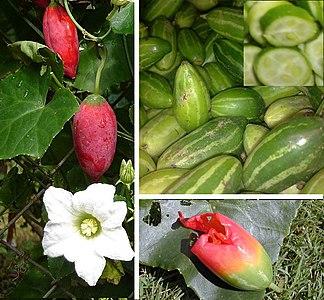
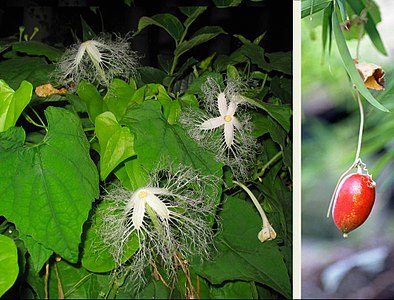

![Trichosanthes dioica inmadura.[10]](https://upload.wikimedia.org/wikipedia/commons/thumb/c/ca/Stuffed_parval_%28pointed_gourd%2C_Trichosanthes_dioica%29.jpg/400px-Stuffed_parval_%28pointed_gourd%2C_Trichosanthes_dioica%29.jpg)
